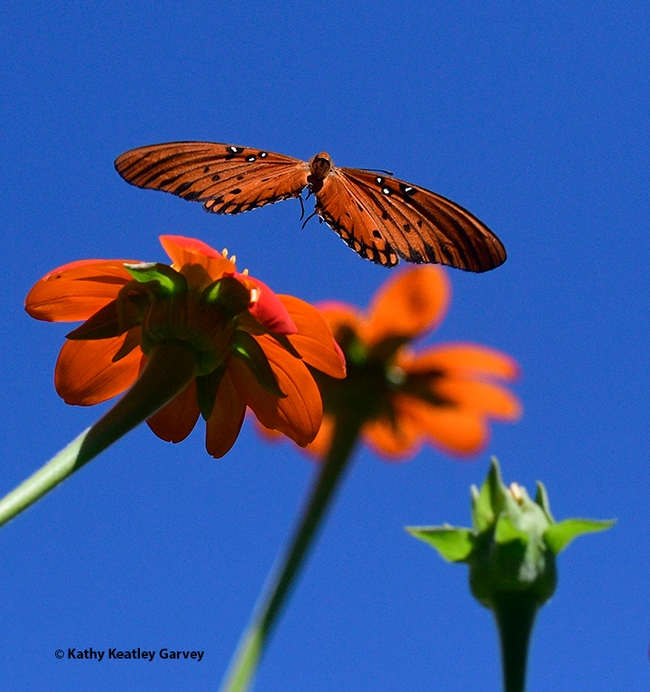- Author: Kathy Keatley Garvey
What we've been waiting for all season...
A migratory monarch butterfly fluttered into our Vacaville garden at noon today (Tuesday, Sept. 17) and nectared on a Mexican sunflower, Tithonia rotundifola.
Then she treated us to a butterfly ballet.
The Danaus plexippus touched down, nectared, shot up, dropped down, and did it all over again, while male territorial longhorned bees tried to make her stay short.
But she hung around for and hour.
Wings up...and she was gone.
And then another flashed by...
It's migratory monarch season.
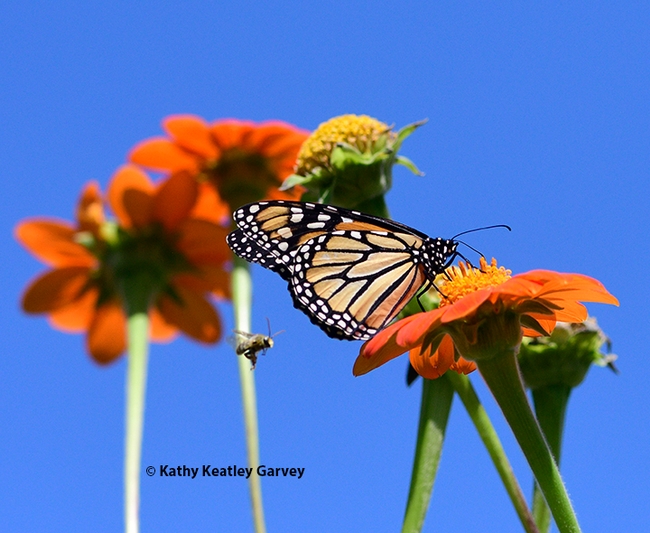
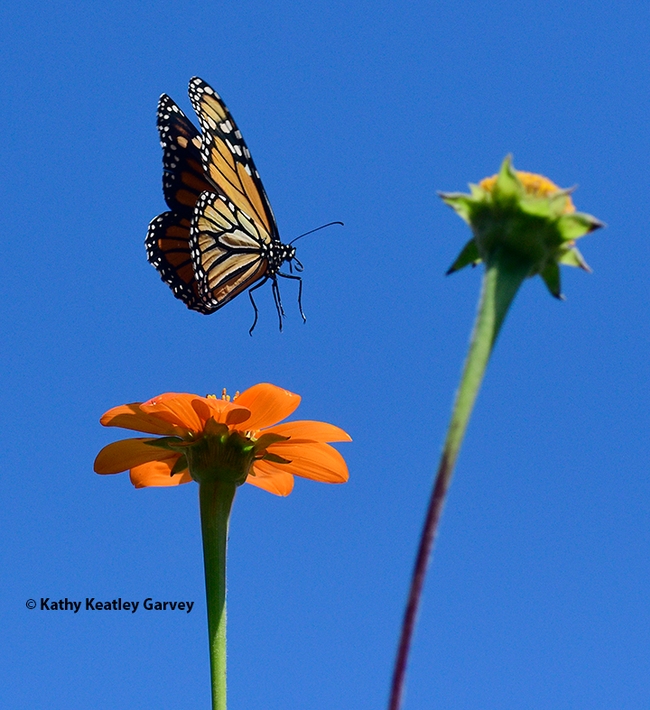

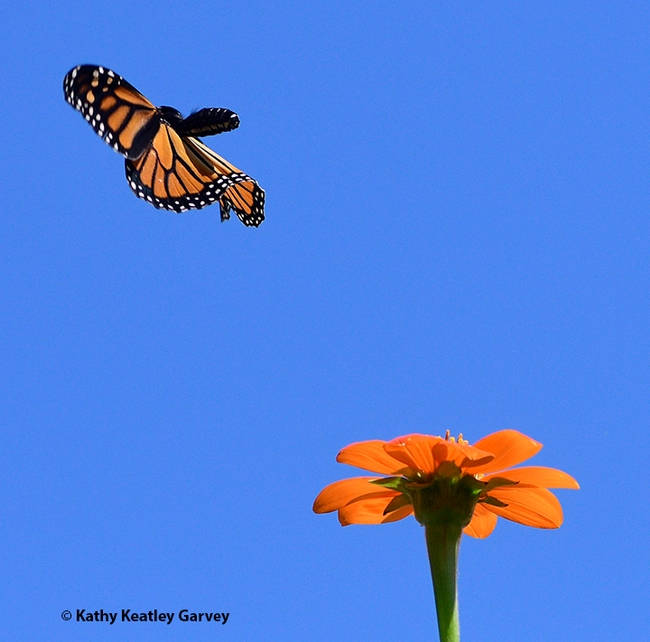
- Author: Kathy Keatley Garvey
In your childhood, somebody probably gave you a jack-in-the-box toy, a music box that you crank up, and then the lid springs opens and out pops a wildly dressed clown, startling you and everyone around you.
A praying mantis sighting is something like that, but without the music box. You're walking in the garden and suddenly you notice that the Mexican sunflower, Tithonia rotundifola, appears to have an extra petal.
You look closer and you see a triangular head with bulging eyes. And a spiked foreleg that looks as if it's extending a hand in (fake) friendship. It's a praying mantis and it's staring right at you.
Such was the case recently when a female praying mantis, Mantis religiosa, popped up between the petals.
Jackie-in-the-box!
"Nice to meet ya, m'dear," she seemed to be saying. "Too bad you're not a bee."
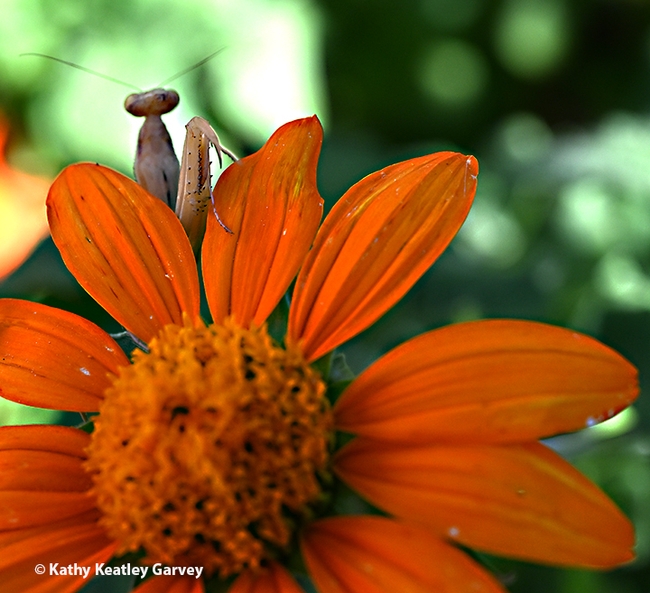
- Author: Kathy Keatley Garvey
So, here you are, a newly eclosed Western tiger swallowtail, Papilio rutulus, eager to sip some nectar from a Mexican sunflower, Tithonia rotundifola, in a Vacaville garden.
It's a warm, windless day, and you're anxious to score, score, score.
You touch down on a Tithonia, but something whizzes by your tails.
Whoa! What was that?
You're startled, alarmed, and irritated. It's a territorial male long-horned bee, probably a Melissodes agilis. He aims to dislodge you from your blossom in his attempt to save the nectar for his would-be girlfriends.
You teeter, then totter, then take off. You touch down on another Tithonia.
Hey! Bee brain! Quit targeting me? Go away!
You head for another blossom, determined to grab a least "a little" nectar.
Stop it! Leave me alone! Go take a vacation!
But the bee isn't about to take a vacation. And he won't allow your "staycation."
Spoiler alert: The butterfly admits defeat and departs the flower garden, exasperated but with tails intact. The bee emerges victorious, its real estate intact.
Score: Bee, 3, Butterfly, 0.
The turf battle is over for today. Tomorrow? That's another day and another battle.
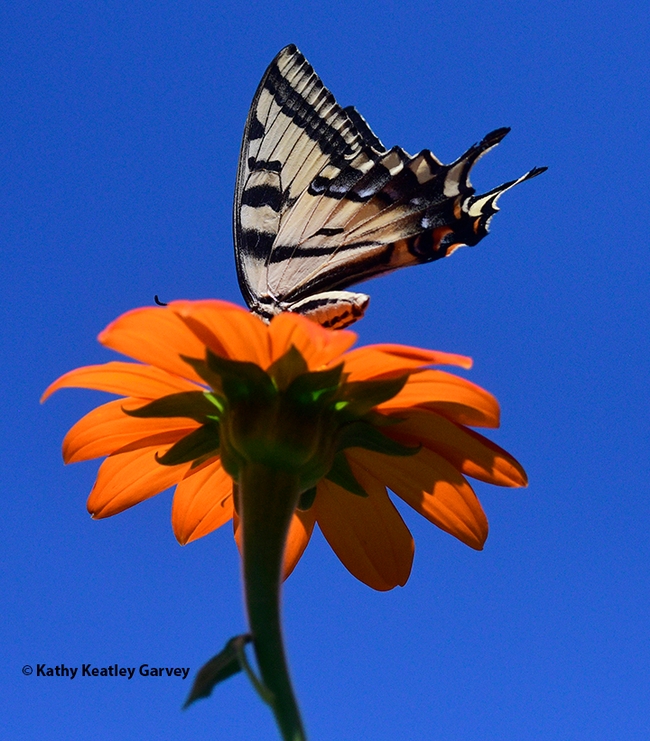
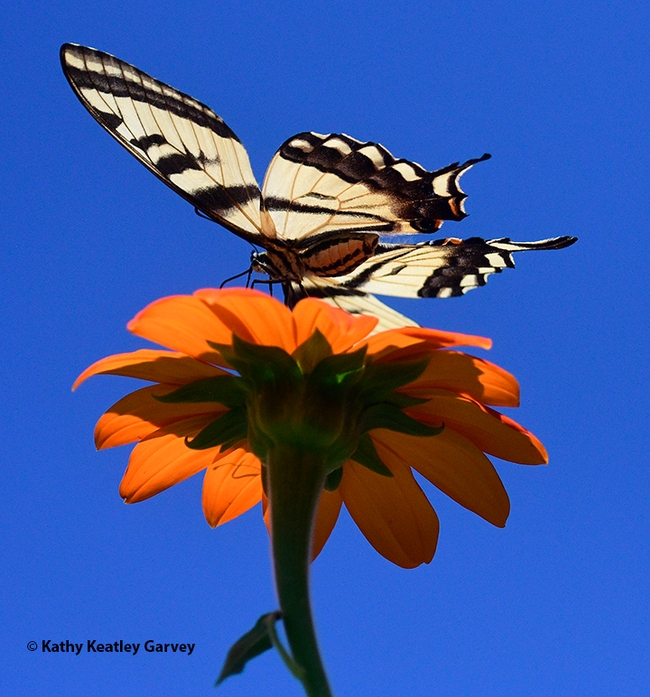
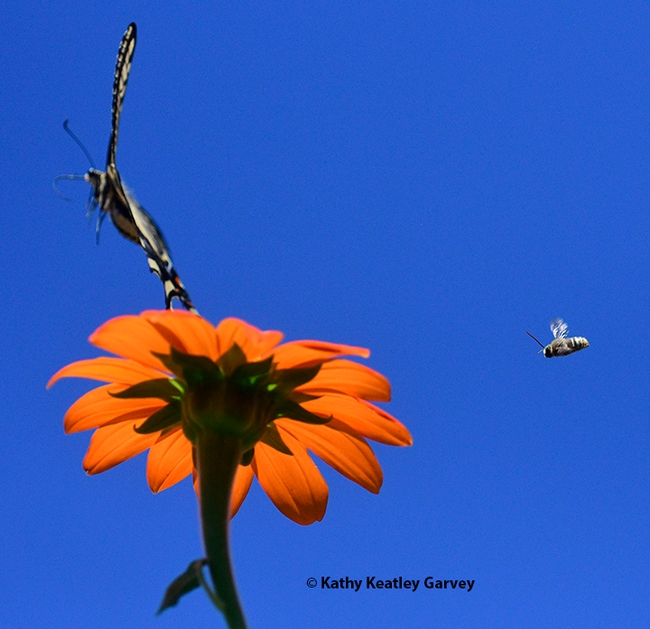
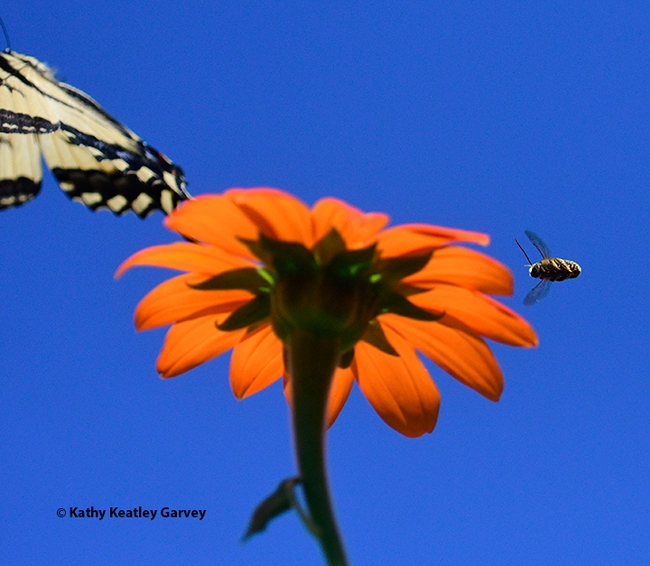
- Author: Kathy Keatley Garvey
When a tiger meets a Tithonia, or a Tithonia meets a tiger, Nature bursts forth in all its glory.
Such was the case when we spotted a Western tiger swallowtail, Papilio rutulus, foraging for nectar on a Mexican sunflower, Tithonia rotundifola, in a Vacaville garden.
It was a newly eclosed swallowtail in perfect form, devoid of ripped, stripped and shattered wings signifying non-successful predatory attempts.
The magnificent butterfly fluttered over the Tithonia, sometimes chased by a territorial longhorned bee. But still it cruised. It raced. It soared.
Spread your wings, little tiger. You have no claws, but you need not pause. The Tithonia, the touchdown, the nectar--they're all yours for the taking.
(Taken with a Nikon D500 with a 200mm lens. Settings: Shutter priority, 1/4000 of a second; f-stop, 6.3; and ISO 800.)
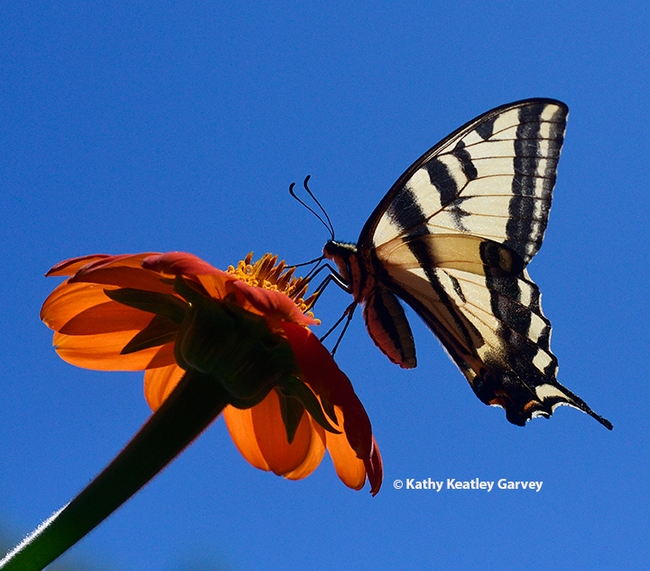
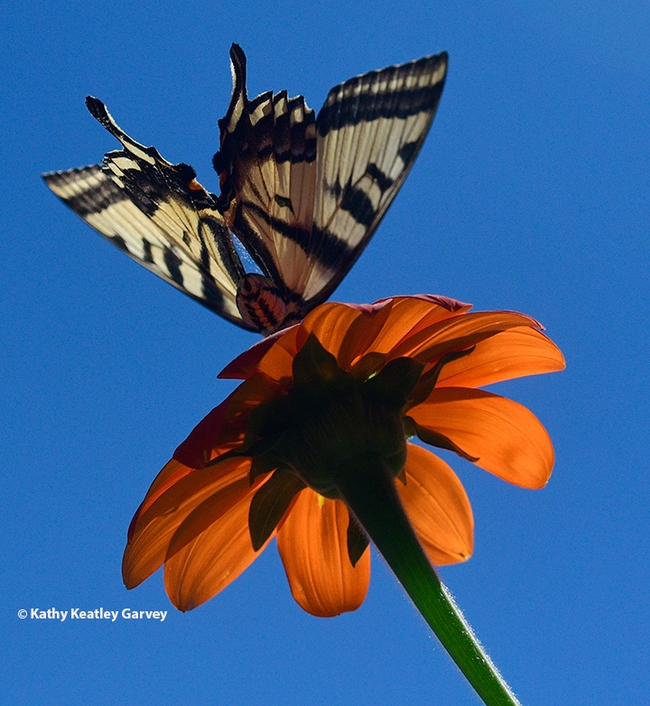

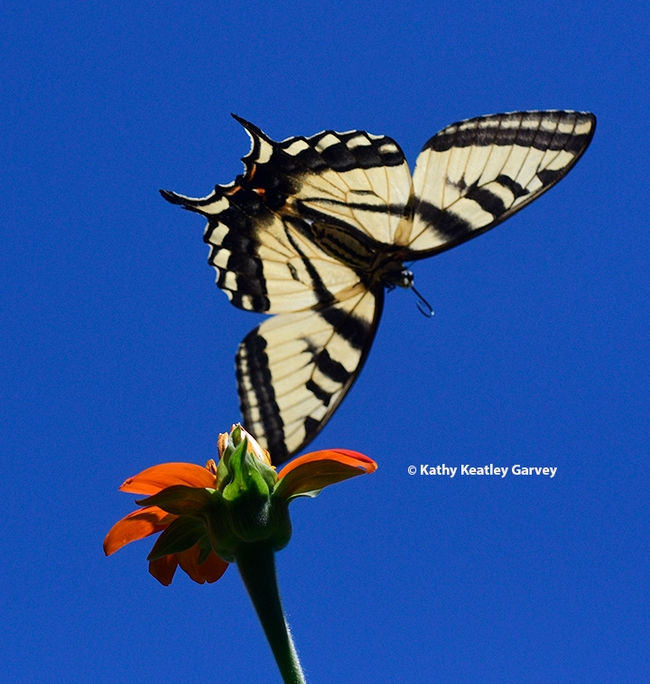
- Author: Kathy Keatley Garvey
The Gulf Fritillary, Agraulis vanillae, and the Mexican sunflower, Tithonia rotundifola, seem made for one another.
Both are a showy orange. Both are show-stoppers. And both attract a photographer's eye.
Especially when a Gulf Frit flutters over a Tithonia on a warm sunny day in a Vacaville garden.
A shutter speed of 1/5000 of a second (Nikon D500 with a 200mm lens) stopped the action.
"This dazzling bit of the New World Tropics was introduced into southern California in the 19th Century--we don't know how--and was first recorded in the Bay Area before 1908, though it seems to have become established there only in the 1950s," writes butterfly guru Art Shapiro, UC Davis distinguished professor emeritus, on his website, Art's Butterfly World. "It can be quite common in the East and South Bay --particularly in Berkeley-- and has been found breeding spontaneously as far inland as Fairfield where, however, it is not established."
Shapiro, who has monitored butterfly populations in Central California since 1972, continues: "There are scattered records in the Central Valley and even up to Folsom, perhaps resulting from people breeding the species for amusement or to release at social occasions. According to Hal Michael, who grew up in South Sacramento, this species bred there in abundance on garden Passiflora in the early 1960s. It seems to have died out by the early 1970s, however. Intolerant of hard freezes, it still managed to survive the record cold snap of 1990 that largely exterminated the Buckeye regionally!"
"This butterfly has no native host plant in California and is entirely dependent on introduced species of the tropical genus Passiflora (Passion Flower, Passion Vine), including the common Maypop (P. incarnata) and P. X alatocaerulea. However, it will not eat all of the Passiflora in cultivation in California."
"In the Bay Area this species can be seen flying any day of the year, if it is warm and sunny enough."
On this day in Vacaville, it was indeed warm and sunny enough: 100 degrees.
